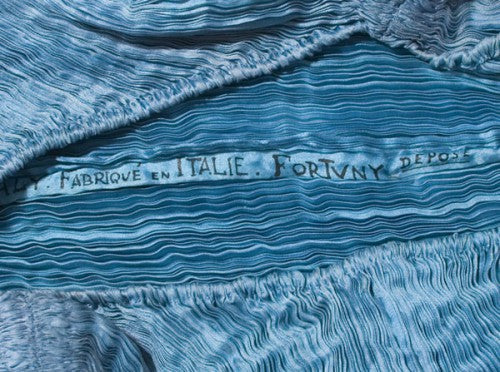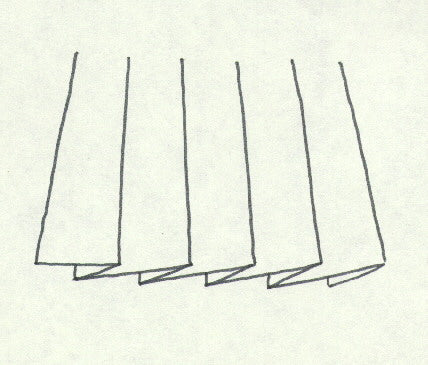Article: What is the difference between Fortuny pleating and mushroom pleating?

What is the difference between Fortuny pleating and mushroom pleating?
We are frequently asked this question. The short answer is: Fortuny pleating is more expensive than mushroom pleating. The long answer has to do with the fabric used, the pleating techniques as well as the amount of fabric compressed together.
Before I delve too deeply into the variables listed above, it’s important I clarify that there are two different types of Fortuny pleating: there is the original silk Fortuny pleating as well as the polyester version popularized by Mary McFadden in the late 1980’s.
The original Fortuny pleating was developed by Mariano Fortuny, a Spanish fashion designer, artist and inventor that started his couture fashions in 1906. Silk was his fabric of choice and the techniques he used were done entirely by hand, just like my grandmother. Neither pleating machines nor polyester fabrics were invented until the mid 1900’s.

Above: Detail photo of Fortuny pleating. Photo from Coletterie.
By the mid 1980’s, forecasters and designers were looking for pleaters to create a pleat that was more expensive looking than the mushroom pleat, readily available in the market. By that time, my father had already established his reputation and was approached by several designers to create a more couture looking pleat. His pleating machines were in transit so he went to another local pleating company and developed a pleat using a very particular quality of Japanese polyester charmeuse. This poly fabric looked like nothing special when it was un-pleated, but after pleating, it was totally transformed.
Mushroom pleating (below) is a more linear looking pleat and looser than Fortuny. It is less expensive than the polyester Fortuny version because it requires fewer processes to pleat and also uses less fabric in the pleat.

Mushroom Pleating – Looser and more linear looking.
The polyester version of Fortuny pleating (below) is less linear and more irregular. This type of pleating uses approximately 30% more labor and the fabric loss factor is much greater: more than 3 to 1 loss of your fabric yardage after pleating. However, this still has no real resemblance to the original silk Fortuny.

Above: Polyester Fortuny-ish pleating.
Below is a silk pleat we made to try to resemble the old techniques used before pleating machines existed.

We combined hand and machine pleating techniques in order to keep the cost down. The fabric we used was a light weight silk in order to prevent a bulky feel. Unfortunately, the original hand pleated fabric my grandmother made was accidentally sold to a jobber. I am, however, working with my father to try to recreate that same look. I will definitely post that when we do.
So, in summarizing, the real Fortuny pleat is silk and made by hand. Newly made Fortuny pleating and mushroom pleating are usually made in polyester unless you order it custom made of another fabric. Most fabric stores won’t stock pleating in silk due to the cost/loss factor. Mushroom pleating is more linear and Fortuny pleating is more mashed up.
If any of this is unclear, please let me know. We definitely encourage your feedback.

